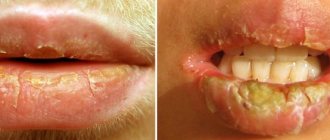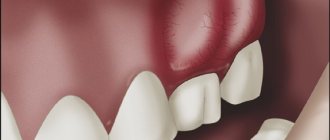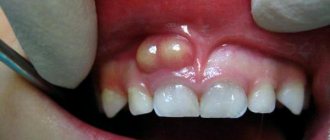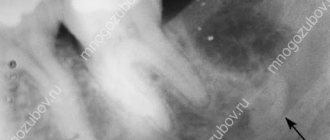Pain in the mouth can make life very difficult. Some people immediately, if the need arises, turn to a specialist for help, while others wait until the last minute and think that the pain will go away on its own. If we talk about flux, then everything is not at all simple. Flux is a strong inflammation that is localized at the root of the tooth. Flux requires immediate treatment. In some cases, there are no options other than removing the inflamed tooth.
Causes of periostitis (flux)
- complication of caries;
- consequences of illiterate root canal treatment;
- as a complication after periodontitis;
- injuries of the maxillofacial area;
- hypothermia;
- inflammation of the gum pocket;
- complications after tooth extraction.
If you do not seek medical help in time, the infection from the subperiosteal region will spread to the bone and soft tissues, and serious surgical intervention will be required in a maxillofacial hospital. In addition, in advanced stages of periostitis, doctors resort to tooth extraction.
Removal of a tooth
After examining the patient, the doctor outlines the treatment path, first of all, deciding whether the tooth can be saved or whether it will have to be removed. If the tooth is damaged, the canals cannot be cured, the tissue between the tooth and the gum is infected, then the tooth must be removed, for which the following procedure is performed:
- the doctor cuts the periosteum;
- examines and treats the wound with antiseptic agents;
- removes tissue damaged by inflammation and removes the tooth;
- puts sutures, installs drainage, at the second visit the drainage is removed, the sutures are changed to self-absorbing ones.
When performing all actions, hygiene rules are carefully observed so as not to introduce a second infection, which will lead to blood poisoning. The operation is not painful as it is performed under local anesthesia.
Types of periostitis
Due to the occurrence:
- odontogenic (most common cause): due to dental diseases;
- traumatic;
- hematogenous: infection spreads through the blood;
- lymphogenous: the infection penetrates through the lymphatic vessels.
By localization:
- diffuse: affects many teeth;
- limited: within 1-2 teeth.
According to the type of disease:
- acute periostitis: pronounced symptoms, rapid course. It is divided into two forms: serous (the presence of transparent exudate in the tissues) and purulent - purulent exudate that can form an abscess. Sometimes purulent discharge enters the oral cavity through a fistula on the gum.
- chronic: quite rare, formed due to an untreated acute form.
What is baby tooth flux?
Periostitis is a purulent lesion of the periosteum. It contributes to the formation of an abscess and the appearance of severe toothache. It can be acute or chronic.
The acute form of the disease is difficult to miss - a lump appears on the child’s gum, filled with purulent masses. As a result, the cheek may “swell” and the cervical lymph nodes often become enlarged.
Chronic flux on a baby tooth often does not manifest itself at all. But at the same time, it has a destructive effect on the child’s jaw and causes negative changes in the functioning of his immune system. It is a consequence of incompletely cured acute periostitis, pulpitis, periodontitis or trauma.
Treatment of periostitis in 2021
This disease can only be treated by a dentist: no home remedies will get rid of infection, swelling and pain.
- The doctor conducts an examination, clarifies complaints and prescribes a computed tomography scan of the teeth.
- After receiving the diagnostic results, an accurate diagnosis is made, and the doctor chooses a treatment method.
- If periostitis is in the initial stage, then the tooth can be saved by eliminating the cause of inflammation (for example, clean the root canals, rinse them). In addition, antibacterial drugs, anti-inflammatory drugs, and painkillers are necessarily prescribed.
- If necessary, the doctor makes an incision in the gum near the causative tooth under local anesthesia to obtain exudate, installs drainage, and prescribes antiseptic rinses.
- In advanced stages, the tooth is removed.
Drug treatment is aimed at:
- individual selection of antibiotics to reduce inflammation and eliminate infection;
- Relieving swelling with anti-inflammatory drugs;
- pain relief.
Also, if necessary, immunomodulators and vitamin preparations are prescribed to strengthen the body.
Why is periostitis dangerous and how to avoid it?
The causes of the disease do not appear overnight, but accumulate in the body over several months or years. Therefore, it is very simple to resist the appearance of tooth flux in an adult:
- Get a routine dental checkup every 6 months. This way you can identify pathologies and anomalies of the oral cavity in the bud and, using simple procedures, prevent their transformation into gumboil.
- Use professional oral hygiene services once every six months. Tartar and hard plaque cannot be removed at home, but they become the cause of many oral diseases.
- Consume more vegetables and fruits. They supply the body with useful substances, and also perform mechanical cleaning of the teeth and interdental spaces during the chewing process.
Possible complications of periostitis in the absence of treatment: sepsis, meningitis, abscess, phlegmon, osteomyelitis and others, up to and including admission to the department of maxillofacial surgery.
Any disease, including gum gum disease, is easier to prevent than to treat. If the inflammatory process has begun, do not rely on traditional methods and self-treatment. The purulent formation will not disappear on its own; only high-quality medical intervention will help eliminate the inflammation and avoid serious consequences.
Symptoms
- increased body temperature;
- complaints of toothache;
- swelling of the soft tissues of the face;
- enlargement of regional lymph nodes (submandibular, cervical);
- lack of appetite;
- restless sleep, capricious behavior.
Treatment of periostitis in children under 5 years of age is always carried out in a hospital setting, since the infection spreads with lightning speed and causes serious complications that threaten the child’s life. Incorrect or untimely treatment can lead to further jaw deformations, since in childhood all bone structures are at the stage of growth and development. Most often, the primary causative tooth is removed, incisions are made to obtain purulent discharge, antibiotics, painkillers, and rinses with antiseptic solutions are prescribed.
As mentioned earlier, treating flux at home is impossible. It is important to contact your dentist immediately. At home, before visiting a doctor, you can rinse your mouth with antiseptic solutions (Chlorhexidine solution, Miramistin). You should not take large quantities of painkillers, as they worsen the effect of local anesthesia in the dentist's chair. If the temperature rises above 38 degrees, you should take an antipyretic drug.
If a fistula has formed on the gum and the purulent contents come out through it, then imaginary relief occurs: the pain subsides, the swelling goes away. But this does not solve the problem: periostitis will worsen again.
Flux can occur in two forms:
- The acute form causes severe pain in the inflamed area, the temperature rises. Toothache is accompanied by pain in the head, radiating to the neck and shoulder. After the flux appears, the cheek swells, the general condition is depressed.
- The disease in its chronic form is not accompanied by such severe pain, but the temperature rises to 37.8 - 38.5 degrees, which confirms the presence of an inflammatory process. The swelling increases, extends to the temporal region, or descends towards the neck. The patient has difficulty speaking and swallowing.
Answers to frequently asked questions
- How to get rid of flux?
You should immediately contact a dental surgeon. He will administer anesthesia (local anesthesia), make an incision and/or remove the tooth. The choice of treatment method depends on the specific clinical situation and the stage of periostitis. In addition, the doctor will select the necessary medications and dosages to eliminate the infection and swelling.
- What means should I use to rinse so that the flux breaks through?
Here it is worth using antiseptic solutions, for example, Chlorhexidine, Miramistin. You can also use saline solutions (1 teaspoon of baking soda and 1 teaspoon of baking soda per glass of water). It is worth noting that if the flux has broken through, this does not mean that it has completely gone through. There will be some relief, but the pain and swelling will return, so you need to urgently consult a dentist.
- What to do after flux treatment?
If such a serious disease as periostitis (flux) has occurred in the oral cavity, this indicates that the condition of the remaining teeth is also extremely unsatisfactory. It is necessary to find out which teeth still need treatment. Examination and consultation are carried out by doctors in our clinic. The best prevention of gumboil development is timely treatment of caries, pulpitis, periodontitis, as well as regular professional oral hygiene.
Symptoms
The clinical picture depends on factors such as the localization of inflammation and the causes of its occurrence, the body’s resistance, and the duration of the disease. Patients experience:
- redness of the mucous membrane;
- enlargement of the submandibular lymph nodes;
- deterioration of health;
- loss of appetite;
- weakness;
- temperature rise is possible.
Patients complain that not only the tooth hurts with gumboil: the painful sensations radiate to the ear, temple, and neck. In addition, swelling appears, due to which facial features lose their configuration. Depending on the location of the pain, the cheeks, upper or lower lip, chin, zygomatic and infraorbital areas swell from the flux. At the same time, the mobility of the jaw and lips is limited, and the patient has difficulty opening his mouth. The pain can be periodic: relief occurs when purulent exudate periodically pours into the oral cavity through the formed fistula.
In chronic periostitis, the symptoms are less pronounced. The pain is periodic, not severe, the contours of the face change slightly.
Diagnostics
To diagnose flux, methods such as questioning, examination, and additional research methods are used: radiography, ultrasound, computed tomography, magnetic resonance imaging, blood test data, culture of exudate, etc. An experienced maxillofacial surgeon who treats patients with flux, can, based on the patient’s complaints and examination, carry out an accurate topical diagnosis of the disease (localization of pus) and select the optimal surgical approach to ensure sanitation of the purulent focus and adequate drainage.
First aid for flux
Of course, there are situations when it is not possible to immediately seek dental help to treat gumboil. In this case, it is recommended to apply a piece of ice to the sore spot, and also regularly rinse the mouth with a decoction of chamomile, sage or calendula (the decoction should be at room temperature).
However, do not expect a miracle to happen: even if the symptoms of periostitis have disappeared, this does not mean that professional treatment should be neglected. If you do not destroy the infectious agents, inflammation will definitely make itself known in the near future.
How does it manifest in children?
All symptoms are similar to those in adulthood:
- pain from the causative tooth;
- facial asymmetry due to edema;
- increased body temperature;
- headache;
- pain when tapped;
- red, swollen gums;
- child's restless sleep;
- poor appetite;
- capricious state.
Most often, pediatric dentists resort to removing such a tooth. It is necessary to eliminate the source of infection so that it does not spread further to the bone or face. Antibacterial drugs and vitamins are prescribed.
In adolescence, sometimes they try to save a tooth. An incision is made in the gum area to drain the pus. The root canals are cleaned. The patient is prescribed rinses, antibiotics, anti-inflammatory and painkillers. If the above methods do not help overcome the infection, they resort to removal.
When the first symptoms of flux appear, it is important to immediately consult a doctor. While the patient is waiting to see a doctor, you can take a pain reliever at home. You also need to carefully brush your teeth and rinse your mouth with an antiseptic solution called Chlorhexidine. You can use a decoction of herbs: chamomile, St. John's wort. It is worth noting that acute pain may go away for a while. But this does not mean that you do not need to visit the dentist. The exacerbation will appear again until the infection is eliminated.
Recommendations for treating flux
- never take antibiotics without a doctor's prescription;
- warming compresses only contribute to the development of periostitis;
- do not apply any bandages to yourself;
- Before visiting the dentist, it is advisable to stop taking painkillers;
- do not take aspirin, it may increase bleeding.
On our website you can quickly find the nearest dental clinic that provides flux treatment. Competent dentists will relieve all symptoms and, most importantly, eliminate the causes of periostitis. Use a simple search system or check out independent ratings of clinics and doctors.











